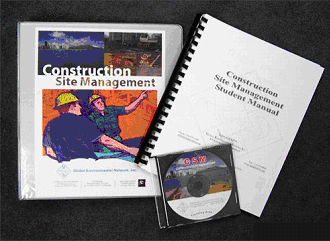Construction Site Management
What is Construction Site Management?
Construction Site Management (CSM) is a new Standard Special Provision (SSP) that appears in Caltrans contracts. It requires controlling potential sources of water pollution that may come in contact with stormwater flows, storm drain systems or watercourses. Construction Site Management is defined as the “proper management of construction activities to preserve living and non-living elements of the ecological, environmental, aesthetic, and social landscape.”
What rules or regulations make Construction Site Management necessary?
The requirement for site management is driven by the Federal Clean Water Act and the USEPA Stormwater Programs. The California State Water Resources Control Board has stipulated in the General Permit for Construction that discharges of most chemicals and other construction wastes are prohibited. In order to ensure compliance with these rules, the California Department of Transportation (Caltrans) has inserted this new Standard Special Provisions (SSP) 07-346 into most new construction contracts.
What is the Contractor’s role?
The Contractor is responsible for controlling material pollution and for managing wastes and non-storm water (water created by contractor activities) during construction by implementing effective storage, handling, use, and disposal practices.
The Contractor is also responsible for training all employees and subcontractors regarding:
A. Materials pollution prevention and control;
B. Waste management;
C. Non-stormwater management;
D. Identifying and handling hazardous substances; and
E. Potential dangers to humans and the environment from spills and leaks or exposure to toxic or hazardous substances.
What will the Construction Site Management Training Class accomplish?
The Construction Site Management training is designed to help construction project personnel understand the basic requirements of pollution prevention laws and regulations in California and follow the instructions for implementing, inspecting, and maintaining the pollution control BMPs selected for use during construction. Students will learn about the provisions of the CA “Statewide General Permit for Stormwater Discharges Associated with Construction Activity,” (Water Quality Order 99-08-DWQ) and the approved Construction Site BMPs related to management of construction sites.
Who needs to take the Construction Site Management Training Class?
Personnel who will be involved with implementing the provisions of the Storm Water Pollution Prevention Plan (SWPPP) in order to comply with the “conditions of the Permit” must be “properly trained” regarding the principal requirements of CSM. This would typically include: personnel who will lay out or install the BMPs selected for use during construction; those who will perform inspections of installed BMPs; those who will perform maintenance of the BMPs; and those responsible for supervising the jobs.
How long is the CSM Training Class, and what will it cover?
The CSM Training Class will be presented in a 4-hour lecture and discussion format. The following topics will be covered:
Background and Regulations will provide an overview of the requirements for compliance with Caltrans Standard Special Provision # 07-346 – Construction Site Management. This SSP is a new standard contract item in most Caltrans highway project contracts. It obligates the contractor to provide specific training, written instructions, and guidance to construction site personnel on how to conduct certain activities to avoid violating the conditions of the General Permit for Construction Activities.
Materials Management will utilize Caltrans Standard BMPs WM-1: Material Delivery & Storage; WM-2: Material Use; and WM-3: Stockpile Management. These BMPs provide guidance on handling and storage of materials.
Waste Management will be discussed using BMPs WM-5: Solid Waste Management; WM-6: Hazardous Waste Management; WM-7: Contaminated Soil Management; WM-8: Concrete Waste Management; WM-9: Sanitary/Septic Waste Management; and WM-10 Liquid Waste Management. These BMPs address the special precautions and procedures needed to prevent storm water from coming into contact with the various categories of stored wastes.
Spill Prevention and Control will discuss the practices and procedures in WM-4: Spill Prevention and Control, which specify different actions in response to three defined categories of potential spills.
Non- Storm Water Management will be addressed using BMPs from the “NS” group. These BMPs provide guidance on the special procedures needed to avoid discharge of polluting materials related to specific construction activities:
NS-1: Water conservation practices
NS-7: Potable water/irrigation
NS-3: Paving and Grinding Operations (including thermoplastic striping)
NS-6: Illicit Connection/Illegal Discharge Detection and Reporting
NS-8, 9, 10: Vehicle and Equipment Cleaning, Fueling and Maintenance
NS-11: Pile Driving Operations
NS-12: Concrete Curing
NS-14: Concrete Finishing
NS-13: Material and Equipment Use Over Water
NS-15: Structure Demolition/Removal Over or Adjacent to Water
What is the CSM Train the Trainer Course and what will I receive?
Train the trainer will prepare the Water Pollution Control Manager to have a more comprehensive understanding of CSM and a better ability to teach that information to all new on site employees and regular visitors. Controlling potential sources of water pollution and managing waste and non-storm water systems or watercourses is the entire purpose of the CSM class.

Full-color and information packed CSM binder: This binder contains copies of required postings, tailgate topics, weekly and daily checklists, references for waste management, spills, emergencies and sampling analyses, AND a complete step-by-step of how to train new onsite visitors/employees. Construction Site Management Student Manual: Contains all the information your employees will need in order to successfully complete and understand the site-specific CSM Course. Construction Site Management Training Disk: This disk contains the Powerpoint presentation that WE used to train you so that you can reference it and showcase it to employees whenever you need to!






